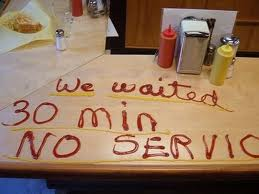It’s an inconvenient truth that in promoting the use of email as a contact method, it is surprisingly easy to leave the wrong message.
I’m not talking about the content here, there’s plenty of focus on that. The issue is about the realities of the customer experience when there has been a lack of thought given to the subject heading and the email address itself.
We wouldn’t set out to create an intentional experience that deliberately stops customers from being able to get in touch with us. Not least, we wouldn’t want to be the one having to explain it to the Board. And worse, it’s an uncomfortable conversation to have to justify it to a customer who is trying to turn to us for help.
Surely that doesn’t happen in today’s hyper-competitive, customer-hugging commercial world? But it does, very much so, and in the process undermines all the good work created by the brand investment, employee engagement programmes and those posters on the wall proclaiming “We put customers at the heart of everything we do” (whatever that means..).
Here are three examples of where it can go wrong. To give them context, the first one has a customer’s perspective providing the commentary:
I’ve had an email from “DoNotReply” – how do I get in touch?
Bought my tickets online. It all went well, it was easy and the people were friendly. But in the confirmation email I had there were a couple of things that weren’t quite clear and so I wanted to check some of the details. Problem was, it was from DoNotReply@— so I wasn’t sure what to do. There was no other way of contacting them apart from links to “Subscribe to our newsletter”, “You might also be interested in these services” and so on. I’ve never had a good experience with their call centre either.
I went back to the company website and looked for the “Contact Us” page but knew I’d have to explain all the information again. Turns out it wasn’t a freephone number so I sent a message using one of those forms. All I’ve had back is a note saying I’m a valued customer and they’ll get back to me in three working days. I’m still waiting.
If they can send me an email, why do they make it so hard to reply to it?
And the point is?
Stopping people replying to automated messages might seem like an operational efficiency but there’s going to be a greater cost in, at best, handling the additional enquiry or at worst, losing the business next time. To get an email from DoNotReply isn’t very friendly language. You’re effectively saying ‘Hey you. Don’t even think about replying. Ha. We’ve got your money so we’re off trying to seduce more new customers like you”.
Either put in place a mechanism for routing emails that do come in or provide an obvious and easy alternative. By their nature, automatically generated messages that fit a template are more likely to generate enquiries from customers whose lives are not governed by templates.
You get the drift. The second and third points follow in the same vein so I’ll rattle through them.
Dear “Info”, who are you, really?
When our customers or clients put the effort in and choose to go to our website, ideally we want them to get in touch. That’s why we have a Contact Us page. How many times have we read that we only have one chance to make a first impression; that it’s the first seven seconds where people make up their minds about us?
So it seems at odds with that if the first contact we offer them is a highly impersonal info@— or Sales@—. It can also be at odds with what the brand promises everywhere else on the site about being customer-focused. Whether your customers are buying a book or chartering a luxury business jet, it’s got to be reassuring for the customer to think they are sending a message to a real person. Simply changing “Info@” to, say, “John@” makes it so much more engaging.
I know you’re here somewhere…
Linked to the two I’ve mentioned, this one’s about customers being able to find your emails later.
Chances are that during the life of your relationship a customer will want to get in touch. And if they’ve got an account number, membership reference, a password reminder or simply want your email address, it’s very likely they’ll look up an old email from you. We all do it, and the first thing we’re likely to do is to sort our inbox messages by sender.
However, the name of the company is often elusive. Instead, we have many messages from “Customer Services”, “Info”, “NoReply” to name but three very generic addresses. We want it to be easy for people to get in touch with us and we don’t want to give them a reason to give up searching or risk going elsewhere. It’s therefore well worth thinking about using an appropriate name that will appear in the customers inbox where they expect it to.
You may have all these and more covered, in which case that’s great. But if there’s any doubt, check it out. It won’t take long and if it starts a conversation between you and your colleagues about what needs fixing and how, that’s got to be better than the alternative “Please explain” conversation around the Board table.
Interested to hear your views, thank you.
Jerry
———
Jerry Angrave
Managing Director, Empathyce Customer Experience
www.empathyce.com | [email protected]
+44 (0) 7917 718 072







